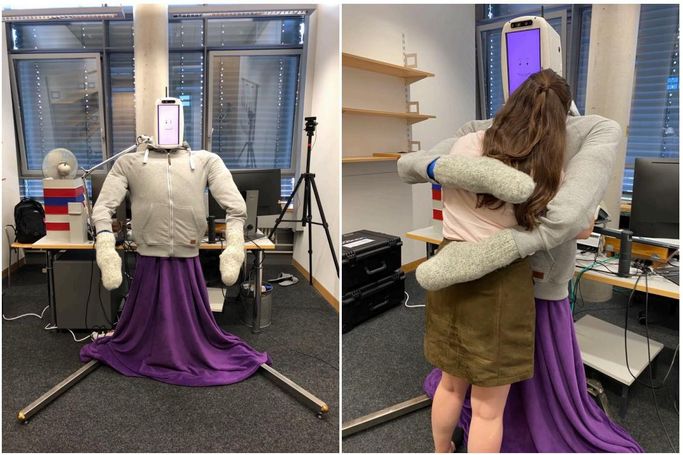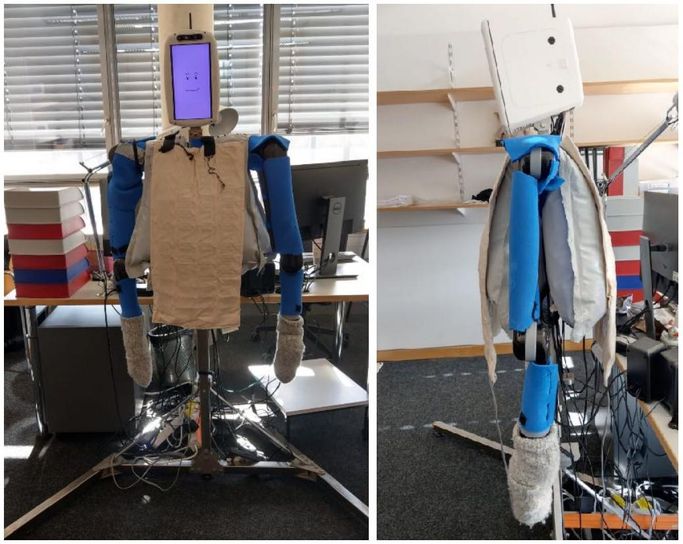If we’ve learned anything over the past few years, it’s how important it is not to take physical contact for granted. Unfortunately, physical contact with humans is something that robots find especially difficult and occasionally dangerous, so that we cannot (yet) safely use them as a proxy for nuanced physical contact with another person. It’s not just that robots are strong and humans are squishy (although both of those things are true), it’s that there are a lot of complex facets to human-on-human interaction that robots simply don’t understand.
In 2018, we wrote about research by Alexis E. Block and Katherine J. Kuchenbecker from the Haptic Intelligence Department at the Max Planck Institute for Intelligent Systems in Stuttgart, Germany, on teaching robots to give good hugs. Over the last several years, they’ve continued this research (along with coauthors Sammy Christen, Hasti Seifi, Otmar Hilliges, and Roger Gassert), and have just published a paper outlining the introduction of a new hugging robot along with 11 commandments that robots can follow to give hugs that humans will be able to appreciate and enjoy—without getting squished.
To grasp why the apparently simple act of hugging demands so much research effort, next time you hug another person pay careful attention to what you’re doing and what they’re doing, and you’ll begin to understand. Hugs are interactive, emotional, and complex, and giving a good hug (especially to someone whom you don’t know well or have never hugged before) is challenging. It takes a lot of social experience and intuition, which is another way of saying that it’s a hard robotics problem, because social experience and intuition are things that robots tend not to be great at. Obviously, robotic embraces are never going to supplant human hugs, but the idea here is that sometimes getting physical human comfort is difficult or impossible, and in these cases, maybe robots could have something useful to offer.
HuggieBot 3.0 is built around two six-degree-of-freedom Kinova JACO arms mounted horizontally on a custom metal frame, on top of a v-shaped horizontal base that makes it easier for humans to get in nice and close. The arms are padded, and the end effectors have mittens on them. Placed over the frame are chest and back panels made of air-filled chambers that provide softness as well as pressure sensing, and there’s a heating pad on top of each air chamber to make sure that the robot is nice and warm.
When HuggieBot detects a user in its personal space, it opens its arms and invites the user in for a hug. Based on the height and size of the user, the robot does its best to appropriately place its arms, even making sure that its wrist joints are oriented to keep the end effector contact as flat as possible. The robot, being a robot, will hug you until you’re all hugged out, but releasing your embrace or starting to back away will signal HuggieBot that you’re done and it’ll let you go, presumably with some reluctance. But if you want another hug, go for it, because no two hugs from the robot will ever be identical.
“Hugging HuggieBot 3.0 is (in my humble and unbiased opinion) really enjoyable,” author Alexis E. Block tells IEEE Spectrum. “We are not trying to fool anyone by saying that it feels like hugging a person, because it does not. You’re hugging a robot, but that doesn’t mean that it can’t be enjoyable.”
Part of making hugs enjoyable for humans involves the use of intrahug gestures, the development and test of which is one of the major contributions of the new paper. Intrahug gestures are the things you do with your arms and hands midhug, and while you may not always be consciously aware that you’re doing them, they could include things like gentle rubbing, pats, or squeezes.

The hug “background” gesture is a hold, but (and you should absolutely try this at home), just doing an extended static hold-type hug will definitely make a hug feel kind of robotic. Human hugs involve extra gestures, and HuggieBot is now equipped for this. It’s able to classify the gestures that the human makes and respond with gestures of its own, although (to avoid being too robotic) those gestures aren’t always directly reciprocal, and sometimes the robot will initiate them independently. While the current version of HuggieBot can only rub, pat, or squeeze, future versions may also be able to perform other intrahug gestures, like leaning, or even tickling, if you’re into that.
Here are all 11 the commandments that HuggieBot 3.0 follows:
- A hugging robot shall be soft.
- A hugging robot shall be warm.
- A hugging robot shall be sized similar to an adult human.
- When a hugging robot is the one initiating the interaction, it shall autonomously invite the user for a hug when it detects someone in its personal space. A hugging robot should wait for the user to begin walking toward it before closing its arms to ensure a consensual and synchronous hugging experience.
- A hugging robot shall autonomously adapt its embrace to the size and position of the user’s body, rather than hug in a constant manner
- A hugging robot shall reliably detect and react to a user’s desire to be released from a hug regardless of his or her arm positions.
- A good hugging robot shall perceive the user’s height and adapt its arm positions accordingly to comfortably fit around the user at appropriate body locations.
- It is advantageous for a hugging robot to accurately detect and classify gestures applied to its torso in real time, regardless of the user’s hand placement.
- Users like a robot that responds quickly to their intrahug gestures.
- To avoid appearing too robotic and to help conceal inevitable errors in gesture perception, a hugging robot shall not attempt perfect reciprocation of intrahug gestures. Rather, the robot should adopt a gesture response paradigm that blends user preferences with slight variety and spontaneity.
- To evoke user feelings that the robot is alive and caring, a hugging robot shall occasionally provide unprompted, proactive affective social touch to the user through intrahug gestures.
The researchers tested out HuggieBot 3.0 with actual human volunteers who seemed perfectly okay being partially crushed by an experimental hugging robot
Source: spectrum












